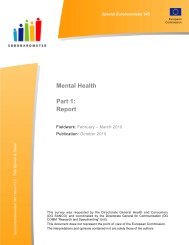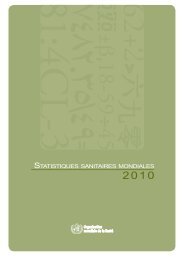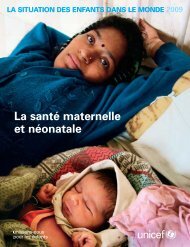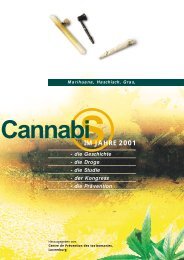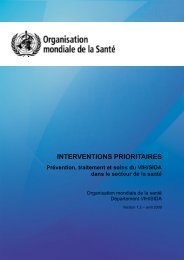Global Tuberculosis Control 2010 - Florida Department of Health
Global Tuberculosis Control 2010 - Florida Department of Health
Global Tuberculosis Control 2010 - Florida Department of Health
You also want an ePaper? Increase the reach of your titles
YUMPU automatically turns print PDFs into web optimized ePapers that Google loves.
35–44 years, 45–54 years, 55–64 years, ≥65 years) and<br />
sex, in line with the way in which deaths are reported.<br />
In countries with no functional VR system, the total<br />
number <strong>of</strong> estimated TB deaths was redistributed into<br />
the different age and sex strata according to the disaggregation<br />
<strong>of</strong> the combined population <strong>of</strong> countries with<br />
VR data (with standardization against the individual<br />
country’s age and sex distribution). TB deaths in HIVpositive<br />
people were not disaggregated by age and sex<br />
due to limited data from countries with functional VR<br />
systems.<br />
<br />
<br />
Projections <strong>of</strong> TB incidence, prevalence and mortality<br />
rates up to 2015 enable assessment <strong>of</strong> whether global<br />
targets set for 2015 are likely to be achieved at global,<br />
regional and country levels. Projections for the years<br />
<strong>2010</strong>–2015 were made using log-linear regression models<br />
fitted to rates from 2006–2009, with the assumption<br />
that recent trends would continue.<br />
<br />
There are many potential sources <strong>of</strong> uncertainty associated<br />
with estimates <strong>of</strong> TB incidence, prevalence and<br />
mortality, as well as estimates <strong>of</strong> the burden <strong>of</strong> HIVassociated<br />
TB and MDR-TB. These include uncertainties<br />
in input data, in parameter values, in extrapolations<br />
used to impute missing data, and in the model used.<br />
We used fixed population values from the UNPD. We<br />
did not account for any uncertainty in these values.<br />
Notification data are <strong>of</strong> uneven quality. Cases may be<br />
underreported (missing quarterly reports from remote<br />
administrative areas are not uncommon), misclassified<br />
(in particular, misclassification <strong>of</strong> relapse cases in the<br />
category <strong>of</strong> new cases is common), or over-reported as a<br />
result <strong>of</strong> duplicated entries in TB information systems.<br />
The latter two issues can only be addressed efficiently<br />
in countries with case-based nationwide TB databases<br />
that include patient identifiers. Sudden changes in<br />
notifications over time are <strong>of</strong>ten the result <strong>of</strong> errors or<br />
inconsistencies in reporting, but may sometimes reflect<br />
abrupt changes in TB epidemiology (for example, resulting<br />
from a rapid influx <strong>of</strong> migrants from countries with<br />
a high-burden <strong>of</strong> TB, or from rapid improvement in casefinding<br />
efforts).<br />
Missing national aggregates <strong>of</strong> new and relapse cases<br />
were imputed by cubic spline interpolation. However,<br />
notification trajectories were not automatically smoothed<br />
over time to avoid introducing systematic errors in countries<br />
where time-changes are reflecting true changes in<br />
the epidemiology <strong>of</strong> TB. Attempts to obtain corrections<br />
for historical data are made every year, but only rarely<br />
do countries provide appropriate data corrections. It<br />
is therefore generally unclear when bumps in notifications<br />
are most likely reflecting reporting errors. Future<br />
regional workshops will include a systematic effort to<br />
correct for such data deficiencies using expert opinion,<br />
for those cases where corrections appear necessary.<br />
Mortality estimates incorporated the following sources<br />
<strong>of</strong> uncertainty: sampling uncertainty in the underlying<br />
measurements <strong>of</strong> TB mortality rates from data<br />
sources, uncertainty in estimates <strong>of</strong> incidence rates and<br />
rates <strong>of</strong> HIV prevalence among both incident and notified<br />
TB cases, and parameter uncertainty in the Bayesian<br />
model. Time-series <strong>of</strong> TB mortality were generated for<br />
each country through Monte Carlo simulations.<br />
Unless otherwise specified, uncertainty bounds and<br />
ranges were defined as the 2.5th and 97.5th centiles <strong>of</strong><br />
outcome distributions. Throughout this report, ranges<br />
with upper and lower bounds defined by these centiles<br />
are provided for all estimates established with the use <strong>of</strong><br />
simulations. When uncertainty was established with the<br />
use <strong>of</strong> observed or other empirical data, 95% confidence<br />
intervals are reported.<br />
The model used the following sequence: (1) incidence<br />
estimation, (2) estimation <strong>of</strong> HIV-positive TB incidence,<br />
(3) estimation <strong>of</strong> mortality, (4) estimation <strong>of</strong> prevalence.<br />
By design, some steps were independent from each other<br />
(for example, step 4 may be done before or after step 3).<br />
The general approach to uncertainty analyses was<br />
to draw values from specified distributions for every



